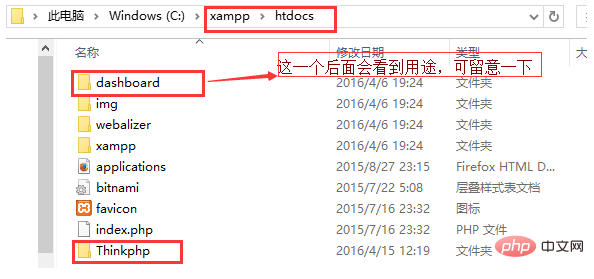
The followingthinkphp frameworkThe tutorial column will introduce you to the problems encountered when building the ThinkPHP framework. I hope it will be helpful to friends in need!
ThinkPHP framework construction and common problems (XAMPP installation failed, Apache/MySQL startup failed)
Part 1: Framework construction
I I am also new to ThinkPHP, so I recorded my current experience and learning steps in a way that I think is easier to understand.
To use ThinkPHP, you must first set up the environment. The following two general steps will be introduced:
Step one: Download the software
1 , ##Build the framework
1. After installing xmapp, we can see an htdocs folder, and we can unzip the downloaded ThinkPHP3.2.3 into this folder;
2. Run XAMPP Control, open Apache and MySQL, as shown in the figure below
3. Open the browser, enter localhost, press Enter, normal In this case, the following interface will appear 
#4. If the above interface appears, it means that the basic framework has been successfully built! , and we noticed that there is a dashboard behind the browser address bar. This is because we have not modified anything, so it displays the page under the dashboard by default. 
Part 2: Frequently Asked Questions

First type:
XAMPP installation failed
Method 1: You can restore all previous operations, that is, uninstall XAMPP, restore or delete all the configuration files you should have, and then reinstall. I've done this before, and experiments show it works.
Method 2: Download vcredist_x86 from my network disk, install it, and then install XAMPP. I think this is better, because otherwise there may be problems later. I’m not sure. I just explained my solution.
Second type:Apache startup failed First case: Port 80 is occupied
Solution:1. The simplest and crudest way: change the port number in the configuration file to something else. The method is as follows:
a. Open XAMPP, click the Config button corresponding to Apache, and select the first line : Apache (httpd.config), modify part of the configuration of the document;
b. Ctrl f, search for 80, find the locations shown in the figure, and change 80 to other ports. I changed it to 81, this To check which ports of your computer are occupied, enter netstat -an on the command line, or directly click the Netstat button in the upper right corner of XAMPP to check and select the unoccupied ports.
## C. After the modification, start the Apache again, it is OK. If it is still a failure, please see the following failure. 2. Check the port occupancy, find the process occupying port 80, open the task manager and kill the process. I may be a little inaccurate here, but the method is like this. I won’t go into specific measures because my modifications will involve other places. The second situation: Port 443 is occupied, because in addition to occupying port 80, the startup of Apache will also occupy port 443
The second situation: Port 443 is occupied, because in addition to occupying port 80, the startup of Apache will also occupy port 443
Solution:
1. The first method is the method mentioned above, which is to kill the process occupying port 443;
2. There is also a simpler method, open httpd-ssl in the xampp installation directory .conf file (C:\xampp\apache\conf\extra\httpd-ssl.conf), I installed it on the C drive, or click the Apache Config button in xampp, select httpd-ssl.conf, and find Listen 443 like this One sentence, change port 443 to 4433 or other;
3. Open the XAMPP installation directory, modify the \apache\conf\httpd.conf file, and find the sentence Include "conf/extra/httpd-ssl.conf" , just comment it out. The third situation: the VC runtime library is missing, just download vcredist_x86 from my network disk and install it, as mentioned before.
Third type: MySQL startup failure1. 3306 port problem, the solution is similar to the above
Finally, if you find it useful, please give it a like and continue to follow the articles shared by the editor. Thank you!
The above is the detailed content of Summarize the problems encountered in building the ThinkPHP framework. For more information, please follow other related articles on the PHP Chinese website!
 Which one is easier, thinkphp or laravel?
Which one is easier, thinkphp or laravel?
 How is the performance of thinkphp?
How is the performance of thinkphp?
 What are the configuration management tools?
What are the configuration management tools?
 console.readline
console.readline
 freelaunchbar
freelaunchbar
 How to restore IE browser to automatically jump to EDGE
How to restore IE browser to automatically jump to EDGE
 What is the difference between css framework and component library
What is the difference between css framework and component library
 Solution to slow access speed when renting a US server
Solution to slow access speed when renting a US server
 How to optimize the performance of Tomcat
How to optimize the performance of Tomcat